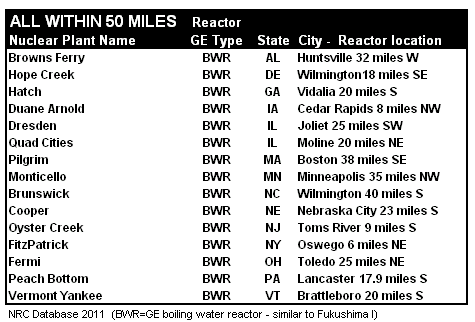Market Drive Regulation
Robert Gillette wrote a classic investigative report for the Los Angeles Times 1979. He described the acceleration of nuclear plant sales and installations and the parallel retreat of regulators. There were no sales of nuclear plants in 1964. By 1966, 63% of new power generation came from nuclear plants. The Atomic Energy Commission (AEC) was swamped with new proposals and short of staff. As larger, more complex reactors were designed, the AEC's budget suffered a series of cuts. Gillette summed it up nicely:
"Larger
reactors would ... build up larger amounts of radioactive wastes, which if
dispersed in an accident, which if dispersed in an accident would
amplify the consequences." Robert Gillette, Rapid nuclear growth at root of accident. Los Angeles Times , April 9, 1979
Despite budget cuts, there were farsighted regulators. One of them, Stephen Hanauer, wrote an internal AEC memo in which he suggested that GE was less than serious about it's reported tests of reactors like those at Fukushima I:
"Recently we have reevaluated the GE test results and decided on a more conservative interpretation than has been used by GE all these years (and accepted by us). We now believe that the former interpretation was incorrect, using data from tests not applicable to accident conditions." Stephen J. Hanauer, Atomic Energy Commission New York Times pdf September 20, 1972 (Article)
GE's use of "data from tests not applicable to accident conditions" is the height of reckless cynicism taken to an extreme.
After praising the logic of Hanauer's the suggestion to discontinue the GE reactors with the Mark I design, nuclear energy chief Joseph M. Hendrie suggested that adopting the plan, "could well be the end of nuclear power." He concluded that such an act would generally create more turmoil than I can stand thinking about." Joseph M. Hendrie, 1972 from the New York Times pdf, March 17 (Article)
Myopic Testing - The Past and Right Now
A flawed approach to testing compounded the problems of US nuclear regulators. A 1962 AEC regulation defined testing as the analysis of all credible accidents. Robert van de Poel's analysis showed the following: "What counted as an unacceptable credible accident was defined by a postulated maximum credible accident (MCA) which was laid down in official regulations in 1962. Changing Technologies 1998 van de Poel p.248 If industry scientists and regulators decided that an event couldn't take place, no matter how arbitrary the decision, the nuclear plant's requirement to withstand that event was forgiven.
Safety testing for Fukushima I by Tokyo Electric and Japanese nuclear regulators followed the exclusionary tradition of maximum credible accidents and its successor, probabilistic risk assessment. The credible level of stress on the plant, based on probability analysis, resulted in tests for a 7.9 Richter scale earthquake.
Why? Because that's what the plant could withstand, if you're a bit skeptical and presume that they tested the maximum stress tolerance prior to performing the official test. Why not test it for higher magnitudes on the Richter scale? It is not as though regulators and energy companies had to create a real earthquake for testing. This testing is done with software. Why not extend the effort to a 9.0 on the Richter scale? How hard is that?
They knew that there was a problem in 1972 and did nothing. They know now there are serious problems and they do nothing.
The US government recommended that the Japanese government adopt a 50-mile evacuation radius to around the distressed Fukushima reactors.
That same US government approved nuclear facilities with the similar designs, GE Mark I boiling water reactors. Each reactor or cluster of reactors is within 50 miles of a the population area listed in the chart below.
That same US government recommends boldly pushing forward with more nuclear installations. It says nothing about the obvious dangers based on a history of flawed assumptions, testing, and performance review for the GE reactor type and the entire array of reactors in place.
(Note: You can view every article as one long page if you sign up as an Advocate Member, or higher).





